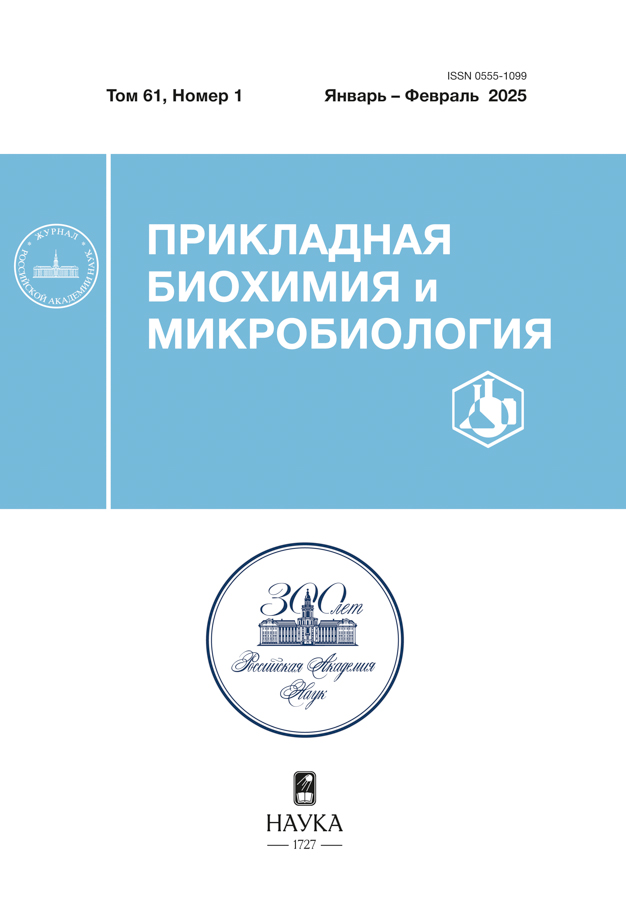Effect of DNA-Binding Proteins on Terminal Deoxynucleotidyl Transferase Activity in Systems with Homopolymer Substrates
- Authors: Sachanko A.B.1, Shchur V.V.1, Usanov S.A.1, Yantsevich A.V.1
-
Affiliations:
- Institute of Bioorganic Chemistry of the National Academy of Sciences of Belarus
- Issue: Vol 60, No 6 (2024)
- Pages: 589-601
- Section: Articles
- URL: https://permmedjournal.ru/0555-1099/article/view/681115
- DOI: https://doi.org/10.31857/S0555109924060038
- EDN: https://elibrary.ru/QGXEUI
- ID: 681115
Cite item
Abstract
In the current work we tested single strand binding protein from E. coli (EcSSB) and DNA-binding protein from S. solfataricus (Sso7d) to evaluate its effects on TdT activity for homopolymer substrates (Tn), that unable to form double helix structures. We showed a significant increase in TdT activity after adding of EcSSB even on the example of homopolymer substrates. Effects demonstrated open application of DNA binding proteins in TdT engineering and DNA-printing. The addition of EcSSB to the reaction mixture led to a significant increase in TdT activity and a shift of the reaction products towards longer oligonucleotides. The maximum effect was observed in a close to equimolar stoichiometric ratio (EcSSB)4:TdT in the presence of Mn2+ cations. In addition, the presence of Sso7d in the reaction mixture led to a slight (up to 15%) decrease in TdT activity for substrates T5 and T15 and a more pronounced decrease for T35 (up to 30%). At the same time, Co2+ cations reduced the inhibitory effect of Sso7d.The patterns and relationships established through our research have potential applications in various fields. Specifically, they can be utilized in protein engineering for the development of fusion proteins that are based on TdT. Furthermore, these findings can contribute to the advancement of novel enzymatic principles for de novo DNA synthesis.
Full Text
About the authors
A. B. Sachanko
Institute of Bioorganic Chemistry of the National Academy of Sciences of Belarus
Email: yantsevich@iboch.by
Belarus, Minsk, 220141
V. V. Shchur
Institute of Bioorganic Chemistry of the National Academy of Sciences of Belarus
Email: yantsevich@iboch.by
Belarus, Minsk, 220141
S. A. Usanov
Institute of Bioorganic Chemistry of the National Academy of Sciences of Belarus
Email: yantsevich@iboch.by
Belarus, Minsk, 220141
A. V. Yantsevich
Institute of Bioorganic Chemistry of the National Academy of Sciences of Belarus
Author for correspondence.
Email: yantsevich@iboch.by
Belarus, Minsk, 220141
References
- Hoose A., Vellacott R., Storch M., Freemont P.S., Ryadnov M.G. // Nat. Rev. Chem. 2023. V. 7. P. 144–161.
- Stemmer W.P., Crameri A., Ha K.D., Brennan T.M., Heyneker H.L. // Gene. 1995. V. 164. P. 49–53.
- Ma S., Saaem I., Tian J. // Trends Biotechnol. 2012. V. 30. P. 147–154.
- Kosuri S., Church G.M. // Nat. Meth. 2014. V. 11. P. 499–507.
- Grosse F., Manns A. // Meth. Mol. Biol. 1993. V. 16. P. 95–105.
- Bollum F.J. // J. Biol. Chem. 1960. V. 235. P. 2399–2403.
- Church G.M., Gao Y., Kosuri S. // Science. 2012. V. 337. P. 1628. https://doi.org/10.1126/science.1226355
- Verardo D., Adelizzi B., Rodriguez-Pinzon D.A., Moghaddam N., Thomee E., Loman T. et al. // Science. Adv. 2023. V. 9. P. eadi0263. https://doi.org/10.1126/sciadv.adi0263
- Deibel M.R., Jr., Coleman M.S. // J. Biol. Chem. 1980. V. 255. P. 4206–4212.
- Sachanka A.B., Trawkina M., Shchur V.V., Usanov S.A., Yantsevich A.V. // Proc. Nat. Acad. Sci. Bel. Chem. Ser. 2023. V. 55. P. 225–233.
- Steitz T.A., Steitz J.A. // Proc. Nat. Acad. Sci. USA. 1993. V. 90. P. 6498–6502.
- Barthel S., Palluk S., Hillson N.J., Keasling J.D., Arlow D.H. // Genes. 2020. V. 11. https://doi.org/10.3390/genes11010102
- Wang Y., Prosen D.E., Mei L., Sullivan J.C., Finney M., Vander Horn P.B. // Nucleic Acids Res. 2004. V. 32. P. 1197–1207.
- Dolgova A.S., Stukolova O.A. // 3 Biotech. 2017. V. 7. P. 128. https://doi.org/10.1007/s13205-017-0745-2
- Baumann H., Knapp S., Lundbäck T., Ladenstein R., Härd T. //Nat. Mol. Biol. 1994. V. 1. P. 808–819.
- Shehi E., Serina S., Fumagalli G., Vanoni M., Consonni R., Zetta L. et al // FEBS Lett. 2001. V. 497. P. 131–136.
- Guagliardi A., Napoli A., Rossi M., Ciaramella M. // J. Mol. Biol. 1997. V. 267. P. 841–848.
- McAfee J.G., Edmondson S.P., Datta P.K., Shriver J.W., Gupta R. // Biochem. 1995. V. 34. P. 10063–10077.
- Bujalowski W., Overman L.B., Lohman T.M. // J. Biol. Chem. 1988. V. 263. P. 4629–4640.
- Bochkarev A., Bochkareva E., Frappier L., Edwards A.M. // EMBO J. 1999. V. 18. P. 4498–4504.
- Chédin F., Seitz E.M., Kowalczykowski S.C. // Trends Biochem. Sci. 1998. V. 23. P. 273–277.
- Schwarz K., Hansen-Hagge T., Bartram C. // Nucleic Acids res. 1990. V. 18. P. 1079. https://doi.org/10.1093/nar/18.4.1079
- Ronaghi M. // Anal. Biochem. 2000. V. 286. P. 282–288.
- Yantsevich A.V., Shchur V.V., Usanov S.A. // SLAS tech. 2019. V. 24. № 6. P. 556–568. https://doi.org/10.1177/2472630319850534
- Yantsevich A.V., Dzichenka Y.V., Ivanchik A.V., Shapiro M.A., Trawkina M., Shkel T.V., et al.. // Prikl. Biokhim. Mikrobiol. 2017. V. 53. № 2. P. 173–187.
- Shlyakhtenko L.S., Lushnikov A.Y., Miyagi A., Lyubchenko Y.L. // Biochem. 2012. V. 51. P. 1500–1509.
- Kuffel A., Gray A., Daeid N.N. // Int. J. Leg. Med. 2021. V. 135. P. 63–72.
- Johns D., Richard Morgan A. // Biochem. Biophys. Res. Commun. 1976. V. 72. P. 840–849.
- Kato K.I., Goncalves J.M., Houts G.E., Bollum F.J. // J. Biol. Chem. 1967. V. 242. P. 2780–2789.
- Flamme M., Hanlon S., Iding H., Puentener K., Sladojevich F., Hollenstein M. // Bioorg. Med. Chem. Lett. 2021. V. 48. P. 128242. https://doi.org/10.1016/j.bmcl.2021.128242
- Aleksandra A.K., Timofey E.T., Irina V.A., Nadezhda A.T., Olga S.F., Nikita A.K. // Life Sci. All. 2022. V. 5. P. e202201428. https://doi.org/10.26508/lsa.202201428
- Kuznetsov S.V., Kozlov A.G., Lohman T.M., Ansari A. // J. Mol. Biol. 2006. V. 359. P. 55–65.
Supplementary files





















